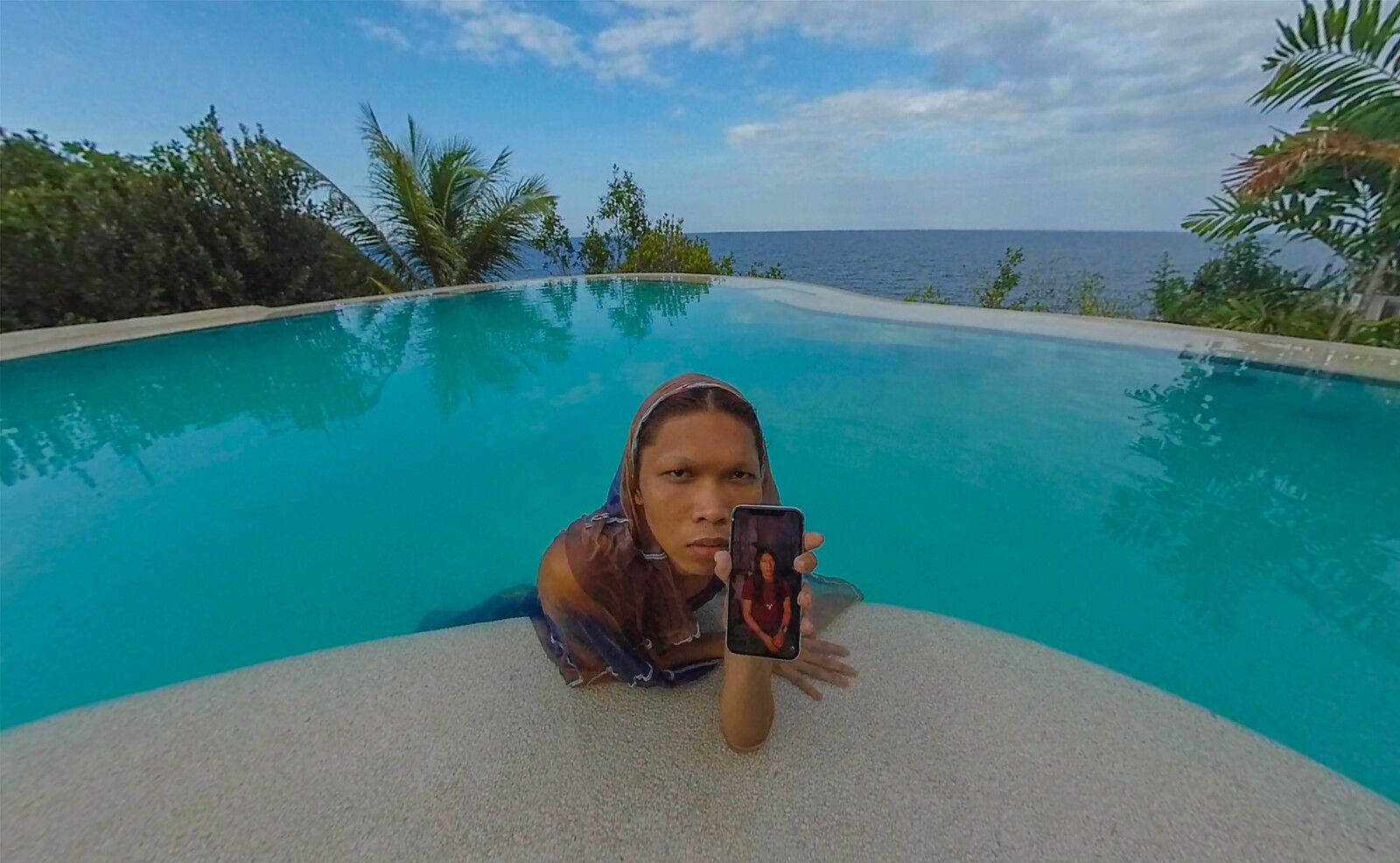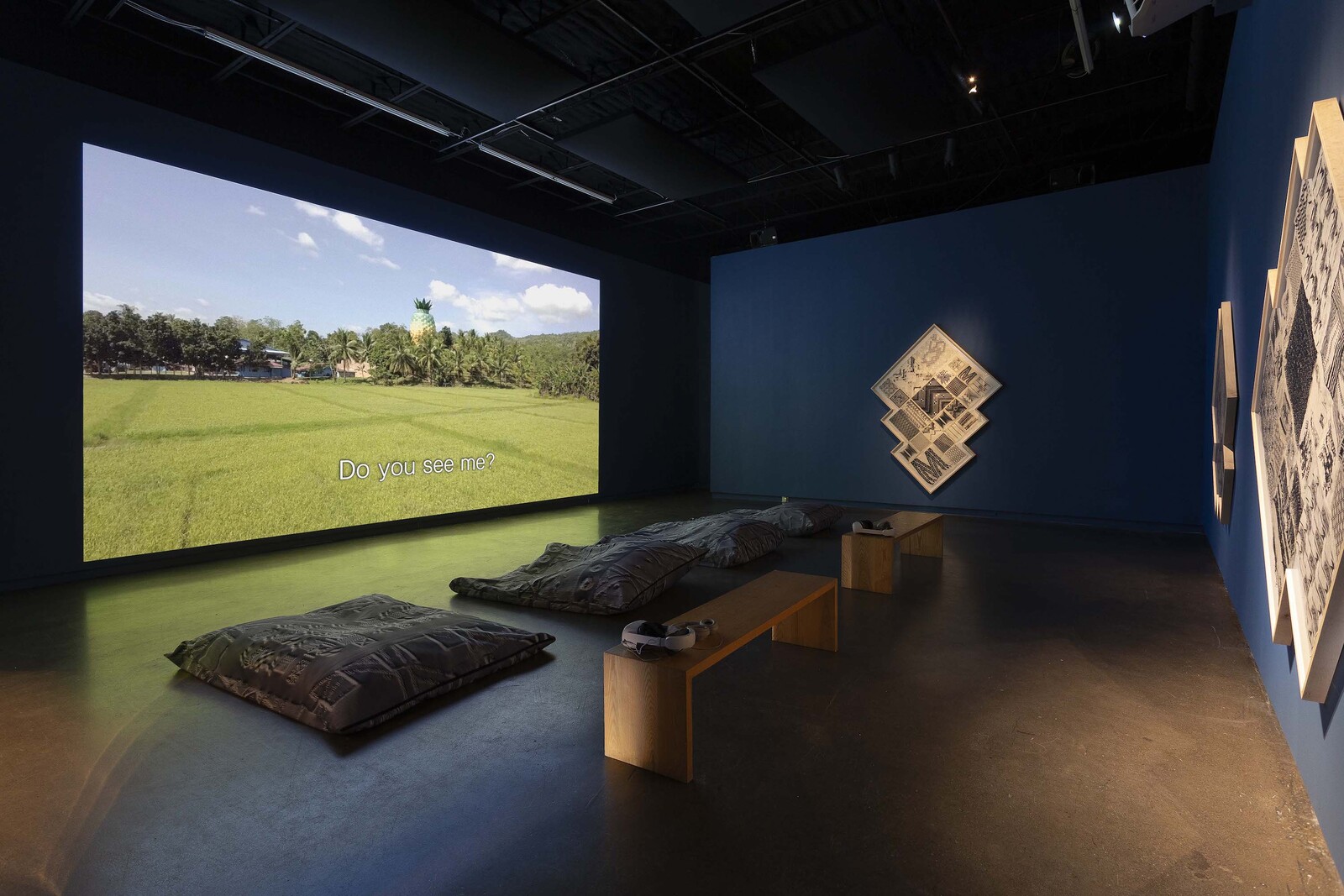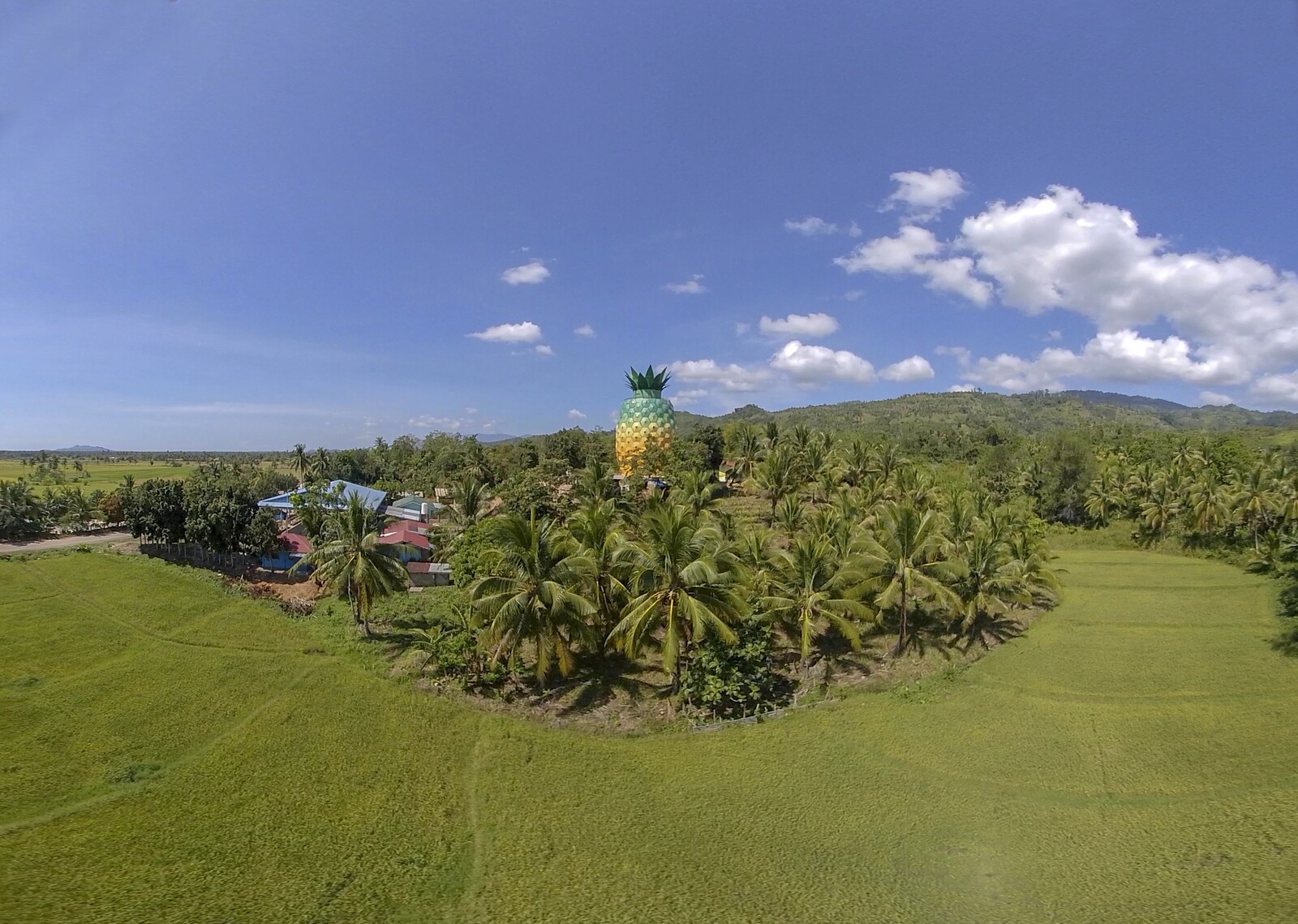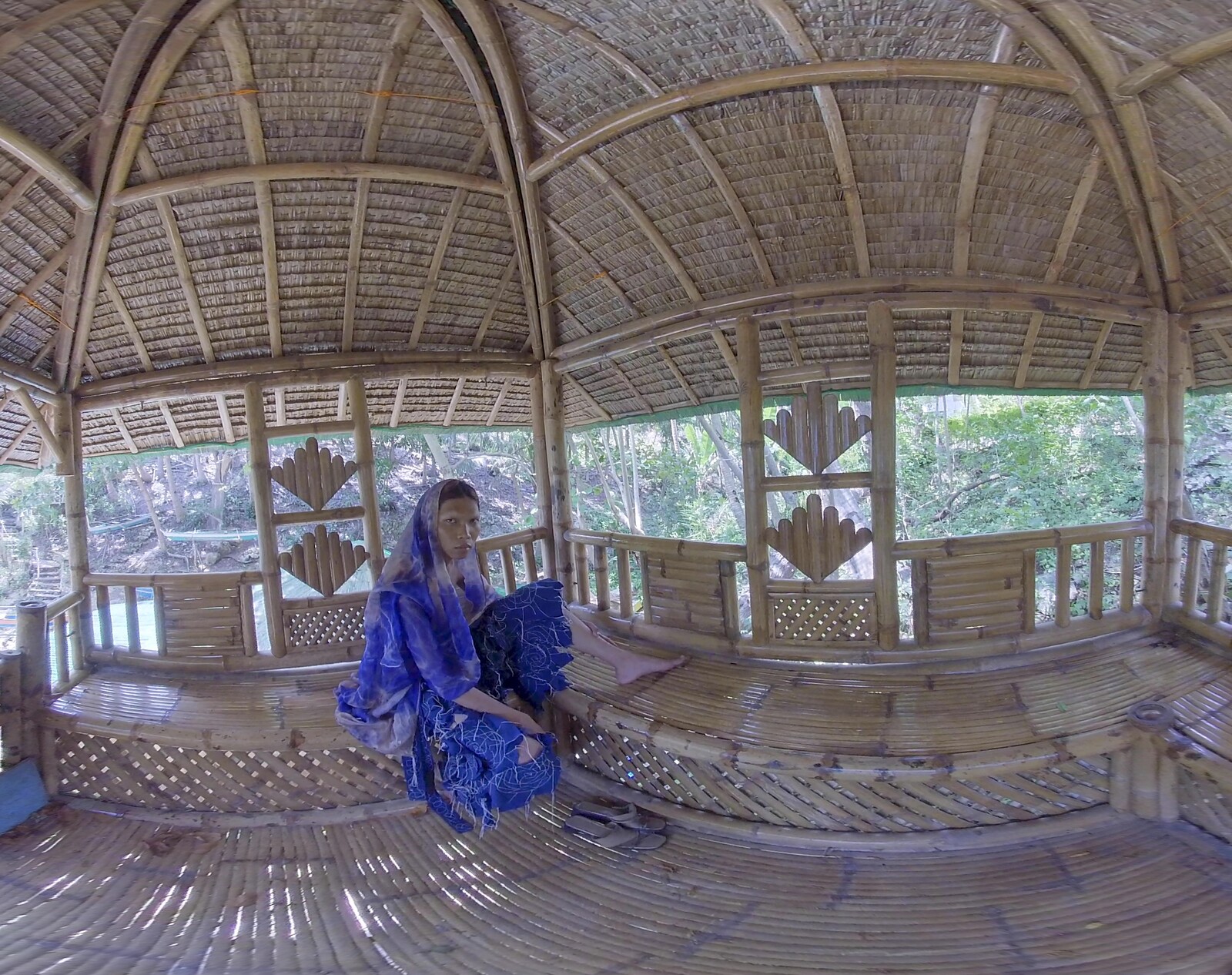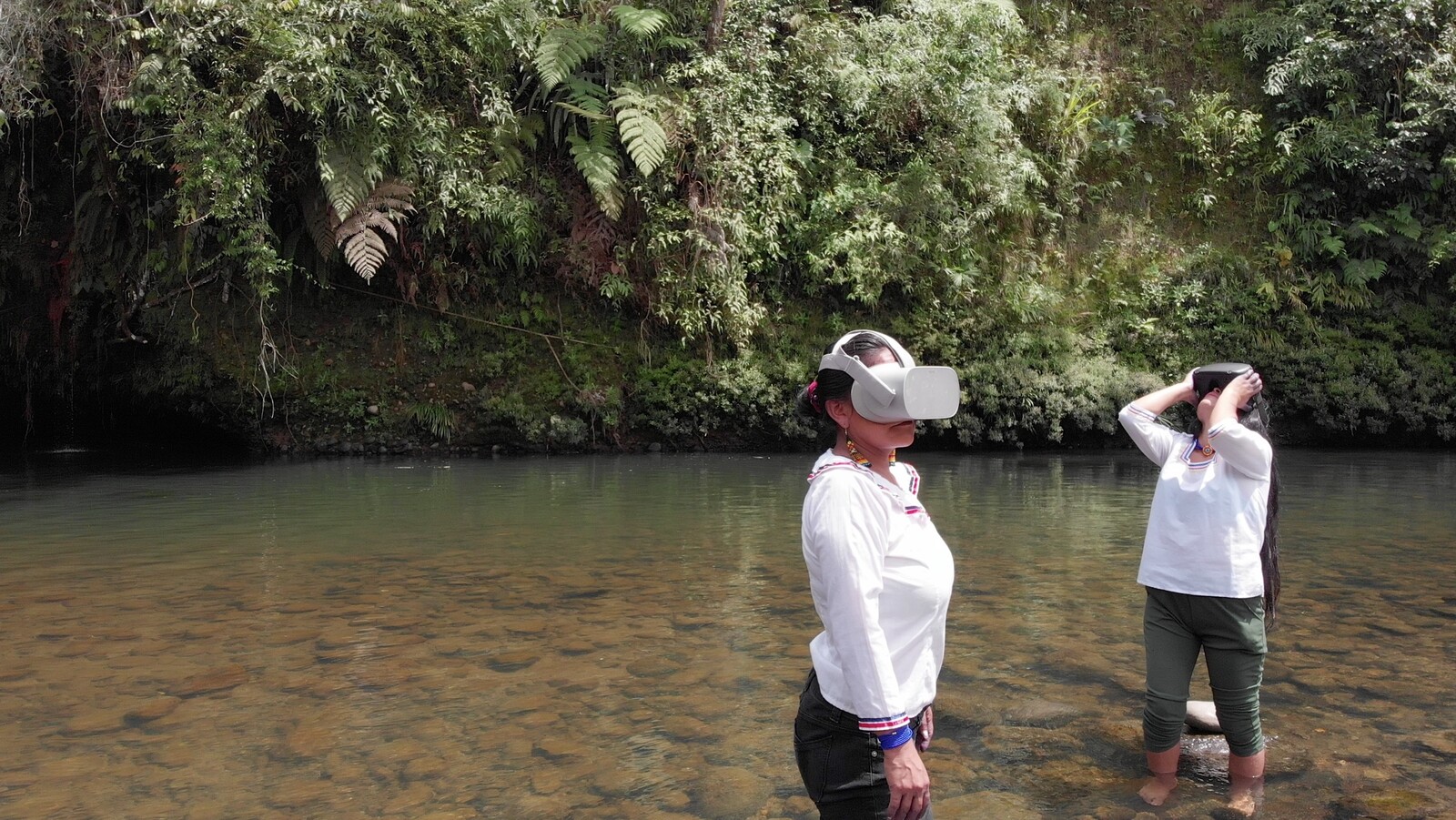In the world of Piña, the title character of this expansive, speculative work of documentary-fiction, there are few boundaries. Piña stretches across temporalities, geographies, and technologies; it’s a world where futures and pasts align, where spiritual knowledge is transformed and disseminated for generational survival. Each element in Stephanie Comilang and Simon Speiser’s collaborative exhibition—a VR work, a wall-sized video projection, and a series of framed textile works, whose patterns repeat on custom-designed floor cushions—contributes to an experience where body, mind, memory, and technology converge.
The project is structured around an elegant spirit, Piña, named after the Spanish and Tagalog word for pineapple, a fruit first introduced to the Philippines in the seventeenth century by Spanish colonizers who considered it a symbol of luxury. In the distant future, Piña is an omniscient AI-guide that holds and transmits matrilineal knowledge by first receiving information, or “data,” uploaded from knowledge-keepers who preserve spiritual and ecological practices, despite the violence of colonization. In the video, Piña’s presence is felt but unseen, as we meet real-world healers and activists. Among them are Kankwana Canelos and Rupay Gualinga of Ciber Amazonas, a group of Indigenous activists in Puyo, Ecuador, who discuss their work forming feminist alliances across the Amazon through radio broadcasting. In an emotionally heightened interview, Janet Dolera, a Babaylan (spiritual medium) and community leader in the Philippines, discusses how she discovered her spiritual calling and meditates on what it means to work as a healer. And Alba Pavón, an Afro-Ecuadorian organizer of the Black Women’s Movement in Pichincha, Ecuador, offers detailed knowledge of plants and healing botanicals while also addressing the history of forced migration of Black peoples into Indigenous communities.
Interspersed with the interviews are scenes of slow ritual, mostly related to water, that show the video’s protagonists in lush rivers and reflective pools wearing VR headsets and manipulating the same textiles that hang in the gallery. Although their actions remain somewhat obscure, having the interview subjects become the messengers performing the fictive, imagined rituals of uploading data to Piña is a critical strategy, one that connects experiences of activism in the present with the possibilities of future knowledge-sharing beyond colonial time and colonizing structures. Amid wide, panning shots of human-altered landscapes in both Ecuador and the Philippines (where Speiser’s and Comilang’s families are from, respectively) open-ended questions are posed and narrated by Piña: Do you see me? Have I come to life? Have I been made again?
In virtual reality, Piña does come alive, in human form embodied by Philippines-based model and designer Lukresia. We fully enter Piña’s world, observing the intimacies of daily life (scrolling a phone, applying make-up) as though a reversal has occurred and we ourselves are the disembodied spirit. The overlapping combination of viewpoints, where we watch and simultaneously inhabit Piña’s space, creates an intensely intimate experience, made technically possible through the use of a three-dimensional, 180-degree camera. In a poignant moment of haunting, Piña guides us through a series of computer-generated rooms (created from scans of the messengers’ bedrooms and domestic spaces), where the frailty of preserving data on paper becomes apparent in minor details. Photographs are torn or frayed; notes remain illegible; shelves of identically bound books fall into decay. How unstable the written word now seems. In another mesmerizing sequence, Piña addresses the viewer directly from within a pool of water: their gaze is striking, emotionally wrenching, heart-stopping even. What is this urging, this longing? That indelible stare reminds us that we are witness to otherworldly transmissions, and are called to act upon them.
The exhibition is grounded by less esoteric references to data distribution in the series of geometrically framed wall works made from the pineapple-fibre fabric commonly used in Filipino formal wear. The piña fabric is embedded with designs that combine traditional Ecuadorian and Filipino patterns with those generated by the artists based on visualizations of neural networks, a nod to how symbols woven into textiles have been used for millennia as cultural information-carriers and vessels for knowledge-sharing. Printed using a 3D printer but stitched together by hand, these data-set textiles bridge human and machine technologies to act as both archive and speculation, documents that are simultaneously future-looking and historical.
This seamless blending of imagined techno-feminist futures with the present-day labors of women shaman and activists is the exhibition’s true strength. In mobilizing such strong feelings of empathy and compassion—qualities of VR that are currently much discussed and studied—the virtual environment dissolves the edges of its own technological limitations such that, even when the headset is removed, the future world of Piña appears to continue. Where so many VR and augmented-reality artworks fail to achieve deeper relevance beyond the fantasy of the apparatus, here VR is intelligently deployed to disseminate the activism and resistance of the present into the future. Viewers are called to question our own experiences—of spirituality, of inheritance, our responses to a dying world, the limitations of our bodies, and what we will pass along. In their blend of science fiction and documentary, Comilang and Speiser offer a more hopeful view, one that is feminist, polyvocal, and structured around intergenerational knowledge and empathy.
“Piña, Why is the Sky Blue?” is also showing at Julia Stoschek Collection, Berlin, through December 4, 2022.
